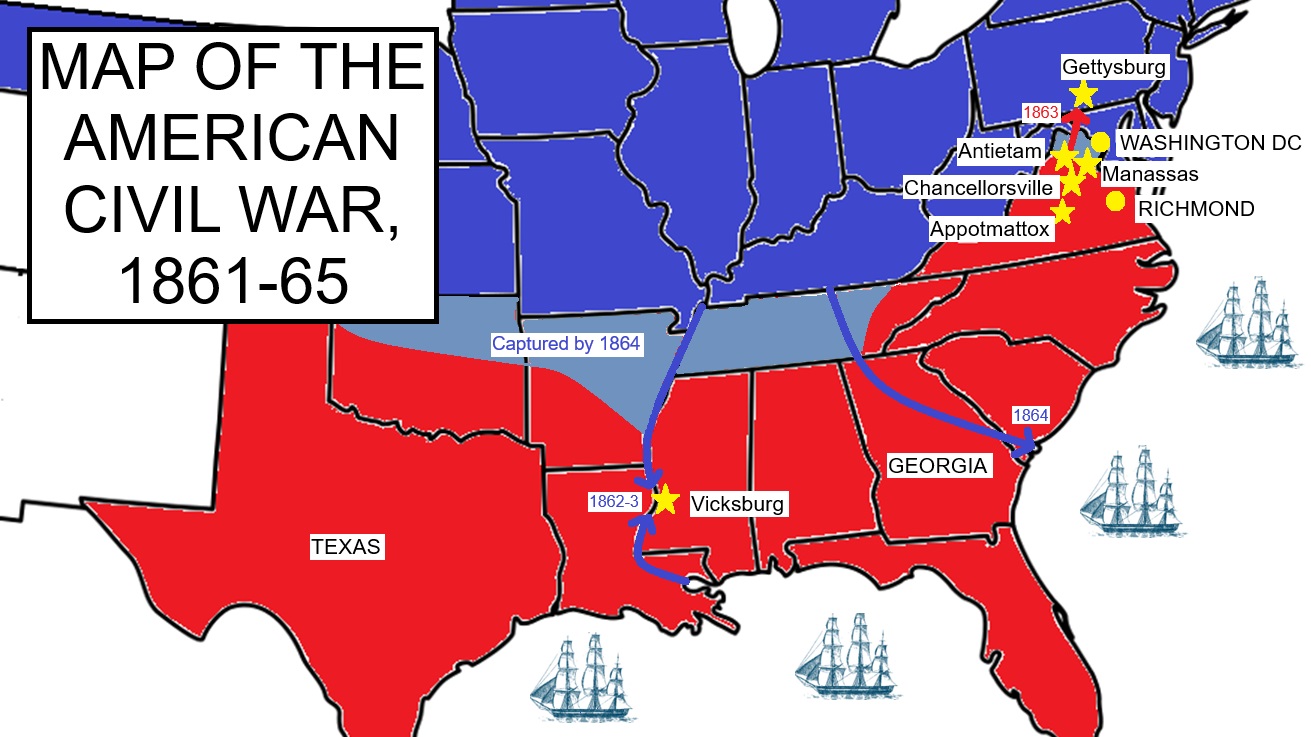Professor Gary Gallagher (2000) argued that the South had
every chance to win the war; all it had to do was hold out (whereas the North
had to invade and conquer it), it had ‘interior lines’ of defence, and the
leadership of the two armies was evenly balanced.
I don’t agree. The North was immensely wealthier, with a much greater industrial capacity, many more railroads, a much larger population and (by the end) three times as many soldiers. The historian Shelby Foote (1990) thought that the North “fought that war with one hand behind its back” – ie it did what was necessary to win, and could have done more if it had needed. Meanwhile, the South had a HUGE area to defend with limited resources.
Especially as the war dragged on, the North was always going to win.
At first, the Confederate side appeared successful:
- An invasion of Virginia by the Union in July 1861 was defeated at the battle of Manassas/Bull Run.
In 1862, three further attempted Union invasions failed.
- In 1862 the Confederate General Robert E Lee attacked Maryland and got to within 60 miles of Washington DC.
He was only stopped at great cost of lives at the battle of Antietam (it was
this battle that convinced Lincoln that he had to free enslaved people and
recruit black Americans into the Union Army).
- In May 1863 Lee won a great victory at
Chancellorsville in Virginia, defeating another Union invasion of Virginia.
However:
- In 1862-63 Union General Ulysses S Grant led a brilliant campaign which captured
the Mississippi valley after the long siege of Vicksburg, splitting Texas from the rest of the Confederacy.
This was called the ‘anaconda strategy’ because, together with a naval blockade,
like the snake, it would slowly strangle the Confederacy.
- On 1 January 1863, Lincoln issued the Emancipation Proclamation, declaring that “all persons held as slaves are, and henceforward shall be, free”. Altogether, 186,000 Black soldiers and 29,000
Black sailors fought for the Union – a tenth of all Union forces
- In July 1863 a second invasion of the North by Lee
was comprehensively defeated in the Battle of Gettysburg.
- In 1864, Grant adopted a strategy of ‘total war’ –
not just fighting the Confederate armies, but taking provisions and forage
and destroying homes, farms, and railroads; ie destroying the South’s
ability to wage a war.
- In 1864 a Union invasion and General Sherman’s ‘March
to the Sea’ destroyed a fifth of the farms in Georgia, and split the South
in two.
- In November 1864 Lincoln – who had looked vulnerable
when the war seemed to be going badly – won a landslide victory in the Presidential election.
Politicians in the South realised there was no hope of a peace.
- In 1865, Lee’s army was surrounded and surrendered at Appomattox.
The Southern States surrendered.
|
- AQA-style Questions
4.
Describe two problems faced by:
• The Union army during the Civil War
• The Confederate Army during the Civil War.
|
